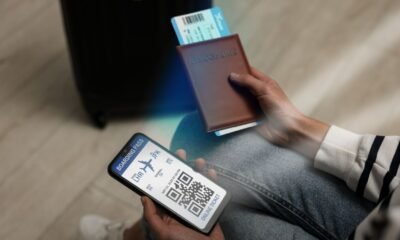Travel
Handling Roaming Fees on a Cross-Canada Road Trip
Published
4 weeks agoon
By
IQnewswire
Canada stretches across nearly 10 million square kilometers, making it the second-largest country in the world. A road trip across this vast landscape promises stunning mountain views, pristine lakes, and charming small towns. However, staying connected during your journey can quickly become expensive if you rely on traditional roaming services. Understanding how to manage connectivity costs while maintaining reliable access to navigation, communication, and emergency services is essential for any traveler planning to explore Canada by car.
Many international visitors discover the hard way that roaming charges can add hundreds of dollars to their travel budget. From checking directions on Google Maps to sharing photos with family back home, every megabyte of data can carry a hefty price tag when you’re connected to foreign networks. This guide will help you navigate the complexities of roaming fees, explore practical solutions for staying connected, and discover how modern technology like eSIM can transform your Canadian road trip experience.
Understanding Roaming Fees During Canadian Travel
Roaming fees occur when your mobile device connects to networks outside your home country’s coverage area. These charges apply to data usage, phone calls, and text messages. For travelers exploring Canada, understanding these costs before departure can prevent unpleasant surprises when the phone bill arrives.
What Causes Roaming Charges on Road Trips
When you cross into Canada, your phone automatically searches for available networks. Once connected to a Canadian carrier, your home provider begins charging roaming rates for every service you use. These fees compensate your carrier for using another company’s infrastructure. The rates vary significantly depending on your home carrier’s agreements with Canadian networks.
Data usage generates the highest costs during road trips. Activities like streaming music, updating social media, or using navigation apps consume substantial amounts of data. Even background processes such as email syncing, app updates, and cloud photo backups can drain your data allowance quickly. A single hour of streaming video might cost between $15 to $30 in roaming charges, while basic navigation could add $5 to $10 per hour.
How Distance and Network Coverage Impact Costs
Canada’s geography presents unique connectivity challenges. Major cities like Toronto, Vancouver, and Montreal offer excellent network coverage, but rural areas between destinations may have limited service. When your device struggles to maintain a connection, it often consumes more power and data trying to locate stronger signals.
The Trans-Canada Highway spans nearly 8,000 kilometers from Victoria, British Columbia, to St. John’s, Newfoundland. Along this route, you’ll encounter vast stretches where cell towers are sparse. Your phone might switch between different carriers’ networks multiple times per day, and each switch can trigger additional connection fees on top of regular roaming rates.
Comparing Fees from Major International Carriers
International carriers structure their roaming fees differently. Some offer daily passes that provide unlimited or high-volume data for a fixed price, typically ranging from $10 to $15 per day. Others charge per megabyte, with rates between $5 and $20 per megabyte for data usage. For a two-week road trip, daily passes could cost $140 to $210, while pay-per-use plans might reach $300 or more depending on your consumption.
European carriers often include Canada in their roaming packages, but travelers from Asia, Australia, or South America frequently face steeper charges. An e sim canada solution typically costs 50-70% less than traditional roaming for the same coverage period. Understanding your carrier’s specific rates and comparing them against alternative options can save hundreds of dollars.
Common Challenges for Travelers Crossing Canada
Road tripping across Canada brings wonderful adventures, but connectivity issues can disrupt your plans. From unexpected dead zones to surprisingly high data consumption, travelers face several obstacles that require advance planning and smart solutions.
Dealing with Spotty Signals in Rural Areas
The Canadian wilderness is breathtaking but challenging for mobile connectivity. National parks, remote highways, and small towns often lack reliable cell service. The stretch between Thunder Bay and Winnipeg, for example, covers over 700 kilometers with numerous areas of weak or nonexistent signal.
These dead zones create practical problems beyond simple inconvenience. If you rely on GPS navigation and lose signal in an unfamiliar area, you might miss turns or struggle to find accommodations. Weather can change rapidly in mountainous regions, and losing the ability to check forecasts or road conditions poses safety risks.
Avoiding Bill Shocks from Data Usage
Bill shock happens when travelers return home to discover roaming charges far exceeding their expectations. This occurs because many people underestimate their data consumption. Background app activity, automatic updates, and cloud synchronization continue even when you’re not actively using your phone.
Social media apps are particularly data-hungry. Posting a few photos to Instagram or Facebook, especially with location tags and high-resolution images, can consume 50-100 megabytes per upload. Video calls with family back home might use 2-3 gigabytes per hour. Without monitoring these activities, a two-week road trip could generate roaming charges exceeding $500.
Managing Connectivity for Navigation and Communication
Navigation apps like Google Maps or Waze require constant data connections to provide real-time traffic updates and route adjustments. While these apps offer offline map downloads, you lose features like live traffic information and business details. A trip from Calgary to Vancouver involves multiple potential routes through the Rocky Mountains, where current weather and road conditions significantly impact travel safety.
Staying in touch with travel companions, especially when driving in multiple vehicles, requires reliable connectivity. Group messaging apps, emergency contact capabilities, and the ability to share locations all depend on network access. When exploring cities like Quebec City or Halifax, finding restaurants, booking last-minute accommodations, or accessing attraction information requires internet access.
Handling Multi-Device Needs on Long Drives
Modern travelers carry multiple connected devices. Smartphones, tablets, laptops, and smartwatches all compete for data access. Families traveling together might have four or five devices requiring connectivity simultaneously. Traditional roaming plans often charge per device, multiplying costs quickly.
Passengers using tablets to watch movies or play games during long drives between provinces consume significant data. If everyone in a family of four streams content independently, you could burn through 20-30 gigabytes on a single day of driving. At typical roaming rates, this single day might cost $200 or more.
Effective Ways to Reduce Roaming Expenses
Smart travelers employ multiple strategies to minimize connectivity costs without sacrificing convenience. These approaches range from simple behavioral changes to leveraging technology and planning ahead for offline access.
Checking Your Home Carrier’s International Plans
Before departing, contact your mobile carrier to review available international plans. Many providers offer temporary add-ons specifically designed for travel to Canada. These plans typically provide a set amount of data, minutes, and texts for a flat fee. Compare these offerings carefully against your expected usage patterns.
Some carriers include Canada in their standard plans at no extra charge, particularly for customers on premium tiers. Others offer special promotions during peak travel seasons. Ask about the specific terms, including whether unused data rolls over, what happens if you exceed your allowance, and whether the plan covers all Canadian provinces equally.
Using Free Wi-Fi Networks Along Highways
Canada offers numerous free Wi-Fi hotspots along major travel routes. Tim Hortons coffee shops, found throughout the country, provide complimentary internet access. Many gas stations, restaurants, and rest stops also offer free Wi-Fi. Provincial visitor centers typically have excellent connectivity and welcome travelers to use their networks.
When connecting to public Wi-Fi, download maps, music playlists, and entertainment content for offline use. Update apps, back up photos to cloud storage, and handle email correspondence while connected to free networks. However, avoid accessing sensitive information like banking apps or entering passwords on unsecured public networks without using a VPN service.
Monitoring Data Consumption with Apps
Both iOS and Android devices include built-in data monitoring tools. These features show which apps consume the most data and allow you to set usage alerts or limits. Third-party apps like My Data Manager or GlassWire provide even more detailed tracking and can send notifications when you approach preset thresholds.
Configure your device to restrict background data usage. Disable automatic app updates, cloud photo backups, and email syncing while on cellular networks. These simple settings changes can reduce data consumption by 30-50% without significantly impacting your travel experience.
Preparing Backup Options for Offline Access
Download offline maps before leaving areas with good connectivity. Google Maps allows you to save specific regions for offline use, though these downloads require periodic updates. Apps like Maps.me or Gaia GPS offer comprehensive offline mapping with hiking trails, points of interest, and topographic details.
Save important information like hotel confirmations, restaurant reservations, and attraction tickets as PDFs or screenshots. Store emergency contact numbers, including your country’s embassy information and roadside assistance services. Having this information accessible without internet access provides peace of mind during your journey.
Benefits of eSIM Technology for Road Trip Connectivity
Electronic SIM cards represent a significant advancement in mobile connectivity for travelers. This technology eliminates physical SIM card swaps and offers flexibility that traditional roaming services cannot match. For road trippers exploring Canada, eSIM provides practical advantages worth considering.
How eSIM Eliminates Physical SIM Swaps
Traditional travel connectivity required purchasing a local SIM card, removing your home SIM, and storing it safely throughout your trip. This process risked losing your original SIM and meant missing calls or texts to your regular number. eSIM technology stores network credentials digitally within your device, allowing you to switch between carriers without physical cards.
You can maintain your home number for important calls while using a Canadian data plan for internet access. This dual-SIM capability means family members can reach you on your regular number while you enjoy affordable data for navigation and browsing. Switching between networks takes seconds through your device settings rather than requiring tools and tiny cards.
Activating eSIM for Instant Network Access
eSIM activation happens digitally, often within minutes of purchase. You scan a QR code or enter activation details through your device settings, and the new profile downloads automatically. This process works anywhere you have initial internet access, whether at home before departure or using hotel Wi-Fi upon arrival.
For travelers landing at Toronto Pearson or Vancouver International Airport, eSIM activation can occur immediately after clearing customs. Within five minutes, you have full connectivity without visiting a store or standing in line. This immediate access helps you request rideshares, contact accommodations, or begin navigation to your first destination.
Cost Savings Compared to Traditional Roaming
eSIM data plans typically cost substantially less than carrier roaming fees. A 10-gigabyte plan covering 30 days across Canada might cost $30-50 through an eSIM provider, compared to $150-300 for similar service through traditional roaming. These savings increase for longer trips or higher data needs.
Beyond base costs, eSIM eliminates surprise charges. You purchase a specific data amount upfront, and once exhausted, service stops rather than continuing at premium rates. This prepaid model provides budget certainty and prevents bill shock. Many providers allow you to purchase additional data easily if you run out, maintaining flexibility without open-ended charges.
Compatibility with Popular Devices
Most smartphones released after 2018 include eSIM capability. iPhones from XS models onward support eSIM, as do recent Samsung Galaxy devices, Google Pixels, and many other popular models. Checking compatibility before your trip takes only a few minutes through your device settings or manufacturer’s website.
Tablets and cellular-equipped smartwatches increasingly include eSIM technology. This compatibility means travelers can maintain connectivity across all devices without purchasing multiple SIM cards or managing separate plans. Some eSIM providers offer multi-device options, allowing you to share a single data allowance across your phone and tablet.
Why Choose Simify for Reliable Connectivity on Your Canadian Road Trip
Selecting the right connectivity provider significantly impacts your travel experience. Simify offers eSIM solutions specifically designed for international travelers exploring Canada, combining affordability with comprehensive coverage and user-friendly features.
Key Features of Simify eSIM Plans
Simify provides data plans tailored to different travel lengths and usage patterns. Options range from short-term plans ideal for weekend getaways to extended coverage for month-long explorations. Plans include generous data allowances suitable for navigation, social media, video calls, and general browsing without excessive restrictions.
The service operates on major Canadian networks, ensuring coverage in cities and along primary highways. You receive the same network quality that local subscribers enjoy, without paying premium roaming rates. Plans include data-only service, which works perfectly with messaging apps like WhatsApp, Telegram, or FaceTime for communication.
Easy Setup Process for Travelers
Simify’s activation process requires no technical expertise. After purchasing your plan online, you receive a QR code via email. Scan this code with your device camera, follow simple on-screen prompts, and your eSIM activates within minutes. The entire process works from anywhere with Wi-Fi access, whether you’re still at home or have just arrived in Canada.
Customer support is available if you encounter any difficulties during setup. The service includes detailed installation guides for various device models, covering iPhones, Samsung phones, Google Pixels, and other popular smartphones. This documentation addresses common questions and troubleshooting steps, ensuring smooth activation even for travelers unfamiliar with eSIM technology.
Coverage Across Major Canadian Provinces
Simify’s network partnerships provide coverage throughout Ontario, Quebec, British Columbia, Alberta, and other provinces. Whether you’re exploring Toronto’s urban landscape, driving through the Canadian Rockies, or visiting maritime provinces, you maintain connectivity in populated areas and along major transportation routes.
While no provider guarantees complete coverage in Canada’s most remote regions, Simify’s network access matches what local residents experience. In cities and towns, you enjoy fast LTE and 5G speeds where available. Along highways connecting major destinations, coverage remains consistent enough for navigation and communication needs.
Essential Tips for Maintaining Connectivity While Driving
Practical habits and smart planning help maximize your connectivity throughout your Canadian road trip. These strategies work whether you’re using traditional roaming, eSIM services, or a combination of approaches.
Prioritizing Data-Heavy Apps
Identify which apps require data access while driving versus those you can use later on Wi-Fi. Navigation apps deserve priority since getting lost in unfamiliar territory wastes time and fuel. Weather apps provide crucial information about upcoming conditions, especially in regions prone to sudden changes.
Delay activities like uploading photos, watching videos, or browsing social media until you reach accommodations with Wi-Fi. Downloaded music through Spotify or Apple Music uses no data, while streaming consumes 50-100 megabytes per hour. These small adjustments can extend your data allowance significantly.
Testing Signals at Rest Stops
Regular stops for fuel, food, and rest provide opportunities to check connectivity and handle online tasks. Test your signal strength at rest areas and note where coverage is strongest. These locations often sit in areas with better tower access than the open highway.
Use rest stop time to send messages, check reservations, or browse local attractions in your next destination. If you’re traveling during winter months, these warm locations offer comfort while you handle digital tasks. Just like travelers might need an esim for europe travel when exploring multiple countries, planning your connectivity around regular stops makes Canadian exploration more manageable.
Sharing Data Among Travel Companions
If traveling with others, coordinate device usage to avoid redundant data consumption. One person’s phone can provide navigation while others use that information rather than running multiple navigation apps simultaneously. Share photos and videos later through AirDrop or direct transfer rather than uploading to cloud services immediately.
Many eSIM plans don’t support native hotspot features, but some travelers use their devices as personal hotspots through specific workarounds. Check your plan’s terms before attempting this, as unauthorized tethering might result in service interruption. When possible, gather everyone together to use free Wi-Fi rather than each person streaming content independently.
Preparing for Weather-Related Disruptions
Canadian weather varies dramatically by season and region. Winter storms can close highways for hours or days, while summer wildfires occasionally affect travel routes. Reliable connectivity becomes crucial during weather disruptions for accessing road condition updates and emergency services.
Download offline maps for your entire route before departing, not just your immediate destination. Store emergency contact information including provincial highway information lines and roadside assistance numbers. Keep your device charged using car chargers or portable battery packs, ensuring you can access critical information even during extended delays.
The Canadian government operates a comprehensive travel information website at Travel.gc.ca where you can check current advisories, road conditions, and safety information before and during your trip. Provincial tourism websites also provide valuable regional information about services, attractions, and current conditions.
Similar to how travelers need an esim for uk and europe when exploring multiple European countries, having reliable connectivity throughout Canada’s diverse provinces requires planning. The country’s size and varied geography demand more attention to connectivity solutions than trips through smaller nations.
Road tripping across Canada offers unforgettable experiences, from watching the sunrise over the Atlantic coast to witnessing northern lights dance across prairie skies. Maintaining affordable, reliable connectivity throughout your journey enhances safety, reduces stress, and allows you to share your adventures with loved ones. Whether you choose eSIM technology, traditional roaming plans, or a combination of approaches, understanding your options helps you make informed decisions that match your budget and connectivity needs.
Frequently Asked Questions
How do I know if my phone supports eSIM for a Canada trip?
Check your device settings to confirm eSIM compatibility. On iPhones, go to Settings > General > About, and look for an Available SIM or Digital SIM option. For Android devices, navigate to Settings > Connections > SIM Manager, where you’ll see eSIM listed if supported. Alternatively, search your phone model online with “eSIM support” to find manufacturer confirmation. Most iPhones from XS onward, Samsung Galaxy S20 and newer, and Google Pixel 3 and later models include eSIM capability. Contact your device manufacturer if you remain unsure about compatibility.
What are the average costs of roaming versus eSIM in Canada?
Traditional carrier roaming typically costs $10-15 per day for unlimited or high-volume data, totaling $140-210 for a two-week trip. Pay-per-use roaming might charge $5-20 per megabyte, potentially reaching $300-500 for moderate usage. eSIM plans generally cost $30-60 for 10-20 gigabytes valid for 30 days, representing 60-75% savings compared to daily roaming passes. The exact savings depend on your home carrier’s rates and your data consumption, but most travelers save substantially with eSIM solutions.
Can I use eSIM for both calls and data on a road trip?
Most eSIM plans provide data-only service, which works perfectly with internet-based calling apps like WhatsApp, FaceTime, Telegram, or Skype. These apps use your data connection to make voice and video calls, often with better quality than traditional cellular calls. If you need to receive calls on your regular phone number, keep your home SIM active alongside the eSIM for data. Your device will use your home number for calls while routing data through the eSIM, though receiving calls internationally might incur charges from your home carrier.
What happens if I run out of data midway through my journey?
When your eSIM data depletes, internet services stop working, but you can purchase additional data through your provider’s app or website. Most eSIM companies offer top-up options that activate within minutes, allowing you to continue your trip without interruption. You might need Wi-Fi access to complete the purchase if you have no remaining data, making rest stops or coffee shops valuable. Some providers send warnings when you approach your data limit, giving you time to plan accordingly.
Is eSIM activation possible without Wi-Fi access?
eSIM activation typically requires internet access to download your carrier profile. You need Wi-Fi or a cellular data connection during the setup process. If you have any data remaining on your home carrier’s plan, you can use that for activation. Alternatively, activate your eSIM before leaving home, at your hotel upon arrival, or at locations offering free Wi-Fi like airports, coffee shops, or libraries. Once activated, your eSIM works anywhere within your coverage area without requiring Wi-Fi.


Why Companies Worldwide Are Hiring Power BI Developers

Experience Pure Android Gameplay with MuMuPlayer Emulator

A Guide To Solar PV For Homeowners

How to Convert a Historic Building into a Hotel: a 2025 Guide

How You Can Integrate AI into Your Small Business For Faster Growth

File Recovery on Android: Myths vs. Facts

Cooler, Safer, Clearer: Why Quality Window Tint Is a Smart Upgrade in 2025

How Medium-Sized Businesses Actually Handle Their Books

Best Travel Vacuum Bags: Pack More and Worry Less with Vacbird Storage Bags

Start Your Morning Right: The Real Benefits of Himalayan Pink Salt and Lemon Water

Carol Kirkwood’s Journey: Her Real Age, Husband, Career, and More

Revolutionizing Healthcare: The Emergence of AI-Driven Analytics

How Machine Learning and AI are Redefining the Future?

Aliza Barber: Meet Lance Barber’s Wife, Age, Life, Profile, Career and Net Worth

Evelyn Melendez: Jordan Knight’s Wife Bio, Marriage, Family, Career and Net Worth

Ilan Tobianah Biography: Family, Marriage, Lifestyle, Career and Net Worth

Who was Alice Marrow? Everything to Know About Ice-T’s and His Mother

King Von’s Autopsy Report: The Truth Behind the Tragic Death

Meet Otelia Cox: The Supportive Wife of Tony Cox – A True Fairy Tale Romance

Tea Leoni and Tim Daly Split – A Closer Look at Their Relationship and Breakup

Why Companies Worldwide Are Hiring Power BI Developers

Experience Pure Android Gameplay with MuMuPlayer Emulator

A Guide To Solar PV For Homeowners

How to Convert a Historic Building into a Hotel: a 2025 Guide

How You Can Integrate AI into Your Small Business For Faster Growth

File Recovery on Android: Myths vs. Facts

Cooler, Safer, Clearer: Why Quality Window Tint Is a Smart Upgrade in 2025

How Medium-Sized Businesses Actually Handle Their Books

Best Travel Vacuum Bags: Pack More and Worry Less with Vacbird Storage Bags

Start Your Morning Right: The Real Benefits of Himalayan Pink Salt and Lemon Water
Category
Trending
-

 News3 months ago
News3 months agoCarol Kirkwood’s Journey: Her Real Age, Husband, Career, and More
-

 Health2 years ago
Health2 years agoRevolutionizing Healthcare: The Emergence of AI-Driven Analytics
-

 Technology2 years ago
Technology2 years agoHow Machine Learning and AI are Redefining the Future?
-

 Celebrity2 years ago
Celebrity2 years agoAliza Barber: Meet Lance Barber’s Wife, Age, Life, Profile, Career and Net Worth






